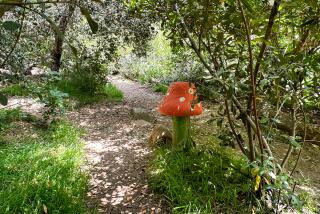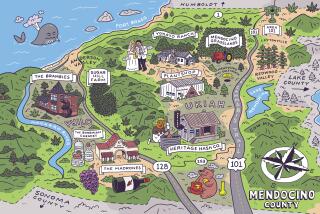Hillside Mustard Too Tenacious to Weed Out : Environment: Large swaths of Cheeseboro Canyon are overrun with non-native plant. Eradication program shows little results so far.
The lush fields of yellow flowers blanketing the countyâs hillsides might be a pleasant distraction for motorists on the Ventura Freeway tired of contemplating the bumper in front of them.
But for the National Park Service, mustard is just one tough weed.
Since December, 1991, the Santa Monica Mountains National Recreation Areaâs fire-management team has been trying to eradicate mustard by setting fires in parts of Cheeseboro Canyon, where acres and acres are overrun with the non-native plant.
Despite their efforts, the mustard just keeps coming back, practically a thicket of six- and seven-foot stalks, pushing aside native plants wherever it roams.
âItâs funny,â one hiker said, pausing on a trail in Cheeseboro Canyon. âI think ever since they started prescribed burns, theyâve had more mustard then ever.â
Fire management officer Ishmael Messer said that without the burn program, areas such as Cheeseboro Canyon would eventually be overtaken by mustard.
âItâs pervasive and itâs very adaptive,â he said.
He admitted that the eradication program, still in its experimental stages, shows little results so far.
âThe visual perspective is that thereâs a lot of mustard out there, and thatâs true,â Messer said.
But he said the park service has measured some minute reductions in mustard plant populations and simultaneous small gains among grasses such as stipa, a native plant that grows in clumps.
The park service began its eradication efforts in late 1991 by burning a 200-acre patch on Modelo Trail. In June, it moved to the middle of the canyon, burning 500 acres.
Now the hills about a mile back on Modelo Trail look like a pointillistâs painting come to life, with millions of yellow dots swaying in the wind.
Part of this yearâs healthy mustard crop can actually be attributed to the prescribed fires. The plant initially responds well to such disturbances, Messer said. Seedbeds probably were full when the fire came through last year, and they stay safe unless the flames burn extremely hot.
âThereâs no way the fire can consume all the seedbed in the ground,â Messer said. âThe idea is to decrease it enough so that we can stop the plant from spreading. But itâs going to take a long time for that to happen.â
Naturalist Milt McAuley, author of âWildflowers of the Santa Monica Mountains,â said the park serviceâs battle against mustard is a losing one.
âThe park service will find out to their dismay that it wonât work,â McAuley said. âYou can do what you want to mustard, but next year, itâs going to come back.â
He cited areas in Topanga State Park in which two natural fires and two prescribed fires failed to eradicate the plant.
âSome of the biggest mustard patches in the park are in those burn areas,â McAuley said. âMustard is overwhelming us in many areas. . . . Itâs bad news. But you canât get rid of it.â
There are 43 species of mustard to be found in the region, but by far the most prevalent is black mustard, or Brassica nigra , which has been giving the hills behind the city of Ventura a yellow-capped appearance for the last two weeks. Although some types of mustard are native, black mustard is not.
The tales about mustardâs California origins are almost as varied as the number of species. The most often told and certainly most romantic story is that priests, traveling with Spanish invaders in the 1760s, brought bags of mustard with them on a journey to Monterey. Along the way, they sprinkled seeds, hoping that when they returned to Mexico the following spring, the flowers would have bloomed and could show them the way.
Another story is that sailors from Mediterranean countries brought with them mattresses stuffed with dry vegetation from home. By the time they arrived in California, the mattresses were moldy and matted down. They brought them to shore, pulled out the old stuffing to change it and thus sowed the seeds.
McAuley said the version he believes is that people scattered the seeds in burn areas during the 1950s and â60s, hoping to rejuvenate the vegetation.
All mustard is edible. The leaves taste sweet for about 10 seconds, then burst into a spicy mustard flavor.
But Bob Brendler, with the Ventura County Farm Advisory Office, does not know anyone who commercially grows or harvests mustard.
âMost of it is just viewed as a noxious weed,â Brendler said. âIt takes up space and soil nutrients.â
One historian, Joseph Russell, writes in his book âCattle on the Conejoâ that early farmers in the area did harvest black mustard, planting it in the same field as oats. According to Russell, mustard seed crops were an important contribution to the areaâs economy.
Mustard is made in Ventura County today--in fact, the worldâs yearly production of 30 million jars of gray poupon is blended at Nabiscoâs Oxnard plant, Nabisco spokesman Mark Gutsche said. But the brown mustard seeds the company uses are imported from northwestern Canada.
âThereâs no connection between our mustard and those pretty yellow flowers you see by the roadside,â Gutsche said.
If there were, the park service might have a market for its unwanted crop. Instead, it intends to continue trying to kill the vegetation, with a 700-acre burn planned for Cheeseboro Canyon in late May or early June. After that, rangers will inspect and decide when to schedule the next burn.
âItâs difficult,â Messer said. âThe Santa Monica Mountains have been so highly manipulated by human beings. Itâs hard for us to determine what actually does belong in Cheeseboro Canyon. But what weâre shooting for is to bring back that oak savannah grassland.â
McAuley has a suggestion for the park service on how to achieve that goal.
âMaybe they should send a bunch of people out there to make sandwiches,â he said.
More to Read
Sign up for Essential California
The most important California stories and recommendations in your inbox every morning.
You may occasionally receive promotional content from the Los Angeles Times.










